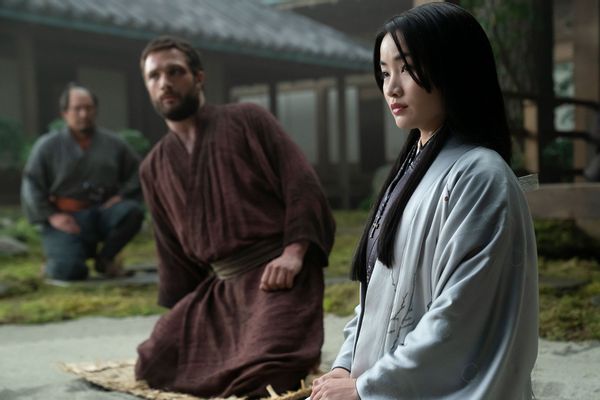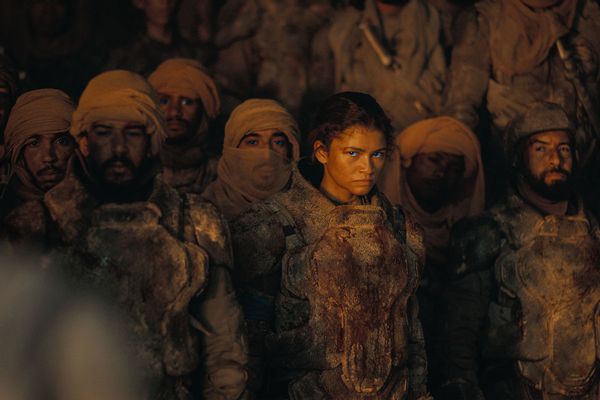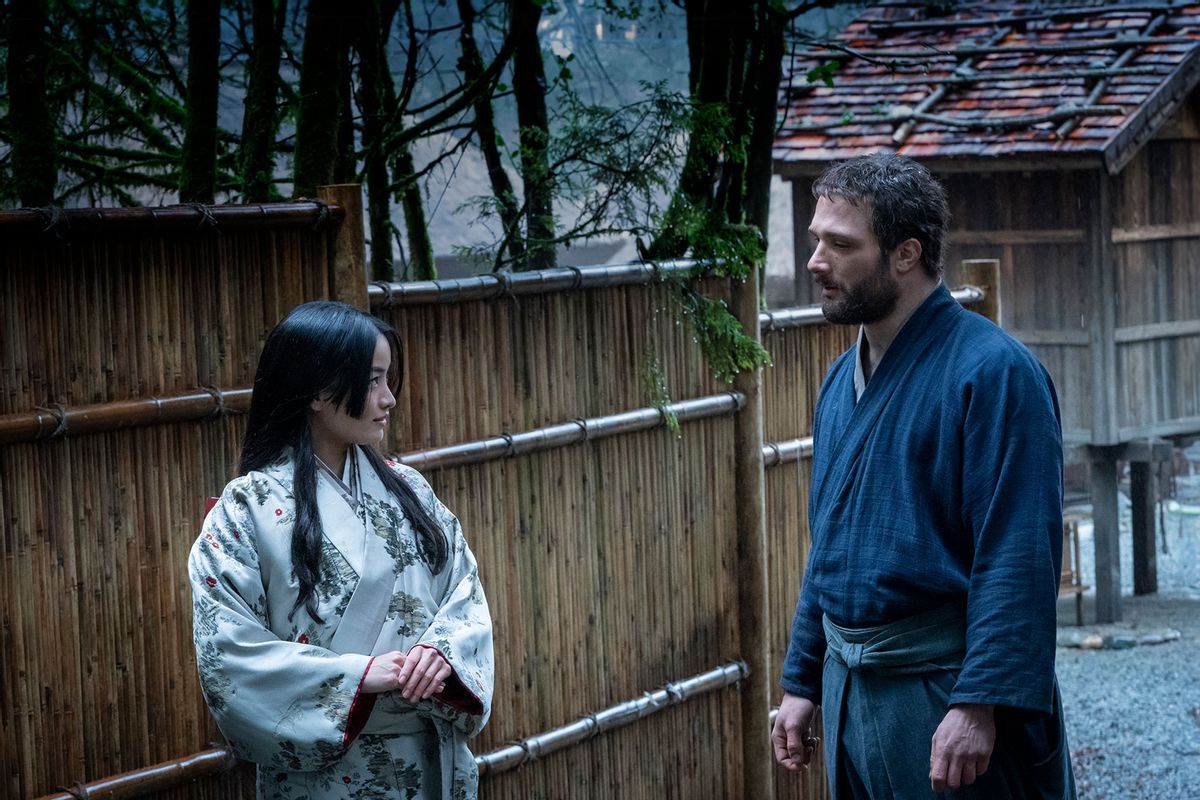In the second episode of FX’s limited series “Shōgun,” English sailor John Blackthorne (Cosmo Jarvis) is ordered to kneel and, at the behest of a Japanese lord (Tadanobu Asano), repeats “I am a dog.” The silly line, delivered at the height of a serious moment, is comedic, but it is also powerful: here is a white man, who had ambitions of establishing a Western foothold in Japan, instead at their mercy and forced to abase himself. It’s not something you see every day in Hollywood.
Instead, the narrative usually goes something like this: white protagonist meets a person (or persons) of color; this person is dealing with poverty, racism or oppression; the white protagonist swoops in and — despite never having to deal with these issues — saves the day. If it sounds like the plot of 1962’s “To Kill a Mockingbird,” 2016’s “The Great Wall,” or 2018’s “Green Book,” that’s because it is. The white savior trope has haunted Hollywood for decades, perpetuating the idea that white people are synonymous with both good and capable, while people of color are reduced to victims, sad struggling figures that are unable to help themselves.
This narrative, catering to assuaging the guilt of a white audience while also centering them, is a one that sells: “Mississippi Burning,” “12 Years a Slave” and “The Last Samurai” have all received awards for this very trope — which makes “Shōgun,” as well as Denis Villeneuve’s “Dune: Part Two,” striking departures. Both of these recent, large productions are finally holding up a mirror to these so-called heroes, a trend that sees entertainment subverting the white savior trope.
“Shōgun” is the latest adaptation of the 1975 best-selling James Clavell novel and chronicles what happens after Blackthorne’s ship crashes onto the shores of Japan, embroiling him in that country's inner political tensions. At first glance, the story seems like it delivers the same tired white savior trope. Here comes the white man looking for riches in Japan only to save the ignorant Japanese from being manipulated by the Portuguese. But FX's 2024 series, created by Justin Marks and Rachel Kondo, overturns this expectation, namely by playing up Blackthrone’s character as a brutish clown.
A running theme and punchline in the series is [Blackthorne's] humiliation.
This is made clear in the very first episode when Blackthorne is reduced to screams, tantrums and flying spittle. He’s practically incapable of answering any question without yelling. When he’s being questioned by the Japanese after landing in their country, he finds the person set to translate for him is none other than a biased Portuguese priest (whose people are at war with the English). In response, Blackthorne – stomping, flailing and neck veins popping – yells, “I will not be spoken for by Catholics!” Of course, no one, save for said Catholic, can understand what he’s saying, which makes him look all the more comedic and ridiculous.
 Cosmo Jarvis as John Blackthorne and Anna Sawai as Today Mariko in "Shogun" (Katie Yu/FX)Another example: When Blackthorne is set before the young Japanese lord Kashigi Omi (Hiroto Kanai), he’s told it’s custom to be polite in Japan, but he responds by calling Omi a “poxy little bastard.” “I will piss on this whole damn country!” he declares shortly before Omi then proceeds to . . . pee on him.
Cosmo Jarvis as John Blackthorne and Anna Sawai as Today Mariko in "Shogun" (Katie Yu/FX)Another example: When Blackthorne is set before the young Japanese lord Kashigi Omi (Hiroto Kanai), he’s told it’s custom to be polite in Japan, but he responds by calling Omi a “poxy little bastard.” “I will piss on this whole damn country!” he declares shortly before Omi then proceeds to . . . pee on him.
In the book, he is also urinated on but Blackthorne lets it happen willingly instead of being forced down in the mud as he is in the show. Marks and Kondo’s alteration frames Blackthorne as brash and clueless. Not to mention, a running theme and punchline in the series is his humiliation.
We need your help to stay independent
Also, take his heroic moments, which often come at the direct expense of his pride. In Episode 3, Blackthorne helps save the lord of the Kanto Region Yoshi Toranaga’s (Hiroyuki Sanada) plot to escape Osaka . . . by making a fool of himself. To distract the Captain of the Guards (Luis Seki Chi) from inspecting the litter that Toranaga is hiding in, Blackthorne steps in, once again shouting nonsensically. (“A woman’s virtue is her glory!”) The over-the-top performance works, though it further characterizes Blackthorne as silly, comedic relief. He looks even more uncouth next to Toranaga and Toda Mariko (Anna Sawa) who both excel at being clever yet composed.
Opening up the story’s perspective to include Toranaga and Mariko, another departure from the original book as well as the NBC’s 1980s miniseries, ensures Blackthorne is the foolish foil to his smooth Japanese counterparts. As Sanada, producer and actor in the show, tells Salon, this was done purposefully: “This time, we created the script, not only through the telling [of] the story through the blue eyes, [but] more Japanese lenses to explain our culture or the story. [. . .] Most of the audience will see Feudal Japan, 1600 Japan through [Blackthorn’s] eyes at the beginning. And little by little, they [are] gonna start understanding what I am thinking, what [the] other Japanese characters [are] thinking.”
The series portrays Blackthorne as a “class clown,” as Vulture calls him, in order to undermine his authority as a white savior. Whereas the show pokes fun at its protagonist to do this, “Dune: Part Two” undermines its hero by turning its savior into a villain.
 Timothée Chalamet as Paul Atreides in "DUNE: PART TWO" (Warner Bros. Pictures)“Dune: Part Two” picks up where the first film left off. Paul Atreides (Timothée Chalamet) is hiding out with the Fremen, the people indigenous to the desert planet Arrakis, just as the Harkonnens, the violent nation at war with the Fremen, seeks to completely wipe them out – Paul along with them. But thanks to the machinations of the creepy, all-women order, the Bene Gesserit, a faction of the Fremen, believe in the prophecy of the Lisan al Gaib, which foretells an outside ruler coming in and liberating them – and who but Paul, the new pasty outlier amongst them, checks all these heroic boxes?
Timothée Chalamet as Paul Atreides in "DUNE: PART TWO" (Warner Bros. Pictures)“Dune: Part Two” picks up where the first film left off. Paul Atreides (Timothée Chalamet) is hiding out with the Fremen, the people indigenous to the desert planet Arrakis, just as the Harkonnens, the violent nation at war with the Fremen, seeks to completely wipe them out – Paul along with them. But thanks to the machinations of the creepy, all-women order, the Bene Gesserit, a faction of the Fremen, believe in the prophecy of the Lisan al Gaib, which foretells an outside ruler coming in and liberating them – and who but Paul, the new pasty outlier amongst them, checks all these heroic boxes?
“Dune: Part Two” undermines its hero by turning its savior into a villain.
Like “Shōgun,” “Dune” is based on a book written by a white guy, Frank Herbert. Depending on who you ask, Herbert’s 1965 novel either continues to uplift or cautions against the white savior as the plot revolves around a central white figure who meets the indigenous Fremen (which draws direct inspiration from the Middle East) and saves them from oppression. But Villeneuve's film falls emphatically into the latter interpretation. “For [Herbert], the book was a warning about charismatic leaders, and he wanted Paul to be more perceived as a dark figure,” the director tells Inverse.
As such, Villeneuve purposefully sets up Paul to seem like he’s embarking on the usual hero’s journey before subverting this expectation. At first, we side with Paul as he ingratiates himself with the Fremen. The director notably cast the nomadic people as mostly people of color, aligned with the source material and as opposed to David Lynch’s own, white-washed 1984 adaptation of the novel. This makes Paul’s, the white outsider’s, quest to ingratiate himself with the Other all the more stark.
He does what so many white figures before him have not: shed his ethnocentrism to appreciate their culture. He learns to walk like them, appreciate the beauty of their land, even ride on the biggest worm of all. All the while, his humility and aversion to power seduces us into cheering him on, as it does for Chani (Zendaya), a staunch nonbeliever in the prophecy, who falls for Paul, too. Throughout the film, Chani insists that the Fremen should have a Fremen leader because “the prophecy is how they enslave us.” She consistently reminds her people that the Fremen need the Fremen, and if there was to be a leader, it would be one of their own. And for the majority of the movie, Paul agrees with her.
But all this is quickly discarded when he goes south. He drinks the Water of Life, announces himself as their savior, and then mounts a war-ending attack on the Harkonnens. The change of heart is as abrupt as his proclamation that he will marry the emperor’s daughter Princess Irulan (Florence Pugh), whom he has never met until that moment. Villeneuve clues audiences in on how to read the about-face by quickly following the announcement with a shot to Chani, whom Paul told not even one minute earlier that he would love forever. The audience is meant to feel as Chani looks: betrayed, furious and heartbroken.
 Zendaya as Chani in "DUNE: PART TWO" (Warner Bros. Pictures)Paul’s descent into villainy is further compounded by the way in which he wins the war for the Fremen. “This is how we’ll survive, by being Harkonnens,” Paul tells his mother (Rebecca Ferguson). If modeling yourself after the bloodthirsty villains who planned on completely annihilating an indigenous culture wasn’t an indication of an evil, tyrant arc, Paul’s embracing of all-out violence does. After defeating the Harkonnens, Paul is told the other Great Houses do not acknowledge him as the new Emperor, so he tells his loyal followers to “lead them to paradise.” In short, off with their heads!
Zendaya as Chani in "DUNE: PART TWO" (Warner Bros. Pictures)Paul’s descent into villainy is further compounded by the way in which he wins the war for the Fremen. “This is how we’ll survive, by being Harkonnens,” Paul tells his mother (Rebecca Ferguson). If modeling yourself after the bloodthirsty villains who planned on completely annihilating an indigenous culture wasn’t an indication of an evil, tyrant arc, Paul’s embracing of all-out violence does. After defeating the Harkonnens, Paul is told the other Great Houses do not acknowledge him as the new Emperor, so he tells his loyal followers to “lead them to paradise.” In short, off with their heads!
Of course, there’s also a cruel irony to his new leadership. Paul finds out the truth of his lineage after drinking the water of life: he is the grandson of Harkonnen’s vicious ruler Vladimir Harkonnen (Stellan Skarsgård). In the end, the Fremen still bow to a member of their oppressor class. Paul may have defeated the enemy, but at what cost?
Like “Shōgun,” “Dune: Part Two” set up what appears to be all the trappings of a white savior only to undermine them, and in both cases, this subversion is well received. In its first six days, “Shōgun” amassed over 9 million global streams, a premiere that outpaced even “The Bear” sequel on Hulu domestically. The “Dune” franchise similarly pulls in the numbers as the sequel is the highest-grossing movie of 2024 so far, raking in over 500 million viewers worldwide.
The so-called post-pandemic age has seen people growing increasingly less trusting of leaders.
The new wave of rethinking white leaders makes sense for 2024, another election year for the U.S. in which the top contenders are . . . wait for it . . . white people. Trump’s and President Joe Biden’s campaigns to let voters of color know their presidency would help them is already underway. Recently, the Democratic Congressional Campaign Committee announced its $35 million campaign targeted at recruiting voters of color. But, just as the popularity of "Shogun" and "Dune" indicate, people aren’t buying into this narrative as much anymore. An NBC News poll found Black opposition to Biden has risen from 12% in 2020 to 20% in November, with other communities of color feeling similarly disenfranchised There’s even a campaign, Listen to Michigan, that pledges to vote uncommitted rather than voting for Biden — unless he changes his continued support of Israel’s genocide against Palestine.
In general, the so-called post-pandemic age has seen people growing increasingly less trusting of leaders. In its place, things like mutual aid, a collective form of care that stems from BIPOC communities, has seen a surge in popularity. Perhaps Blackthorne and Paul can serve as a reminder to politicians and directors that white people can’t and don’t save communities of color. We each, all of us, take care of one another instead.

Shares